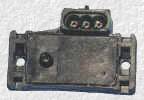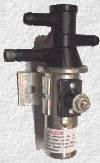|
|
|||||||||
|
| Introduction | First Models | Sensors | Engine Management Basics | ||
| Requirements | Sub-systems | Tuning | Sizing Injectors | ||
| gas tank mods | Fuel supply system | My first ECU | F.I. Links - Sources | ||
| Special Project Wide Band Oxygen Meter | O2/Tach/Vac/Timing Logger | ||||
| Other peoples Triumph F.I. Installations/Projects | |||||
| Special Project Megasquirt - The Quintessential D-I-Y Fuel Injection ECU | |||||
| Building a Custom GT6 Manifold | Whitey's F.I'ed Spit6 Project | ||||
| Building an MGB manifold | Experimental twin bodies on a GT6 | ||||
| Building a twin TB MGB manifold | The other half of the story | ||||
Sensors
| This is just a 'quickie' reference
to the various sensors that can be used by the ECU to determine operating
parameters and track engine performance. These vary dramatically in mechanical
shapes and sizes, but for the most part, you' be able to spot these on someone's
engine using the photos below.
|
||
 |
An Oxygen Sensor mounted in the exhaust system measures the oxygen content to determine if you're running rich or lean. There are 1,3,4,and 5 five versions. | |
| The Intake Air Temperature Sensor lets the ECU determine the 'air density'. Cooler air needs more fuel, warmer air is thinner, requiring less fuel. |
|
|
|
|
Just like the air temp sensor, the engine Coolant Temperature Sensor let's the ECU determine if adjustments are needed based on whether the engine is warmed up or not. | |
| The MAP (manifold absolute pressure) Sensor is simply an electronic version of a vacuum gauge. It is used by the ECU to assist in determining engine load. (are you mashing the peddle at low revs...vacuum drops.. etc) |  |
|
|
|
The Throttle Position Sensor is like a radio volume control. As you open/close the throttle plates, it lets the ECU know how far open/closed the throttle is. This is used in conjunction with the map sensor (among others) to determine engine load. | |
| The Idle Bypass Valve, is the equivalent of the idle step-up function performed by the choke. When the engine is cold, it lets air get to the engine to 'up' the idle rpms a bit until things warm up. Similar use is when an A/C compressor kicks in loading the engine, this valve would be activated to compensate of for the load on the engine to keep the engine idling where it's needed. |  |
|
|
|
A Knock Sensor is quite literally a microphone, tuned to detect the pre-detonation from timing that is too advanced or an overly rich mixture. These aren't that common on small engines as other component noise can easily mask the sound at high revs. | |
| There are a variety of sensor
shapes and sizes for each of the items pictured above. This is just a sampling of
the info the ECU can use to properly control the fuel/air ratio.
|
||
| Introduction | First Models | Sensors | Engine Management Basics | ||
| Requirements | Sub-systems | Tuning | Sizing Injectors | ||
| gas tank mods | Fuel supply system | My first ECU | F.I. Links - Sources | ||
| Special Project Wide Band Oxygen Meter | O2/Tach/Vac/Timing Logger | ||||
| Other peoples Triumph F.I. Installations/Projects | |||||
| Special Project Megasquirt - The Quintessential D-I-Y Fuel Injection ECU | |||||
| Building a Custom GT6 Manifold | Whitey's F.I'ed Spit6 Project | ||||
| Building an MGB manifold | Experimental twin bodies on a GT6 | ||||
| Building a twin TB MGB manifold | The other half of the story | ||||
![]()
©1987-2010
All material copyright© Teglerizer 1996-2008last edited
3/15/08

hits since last reset